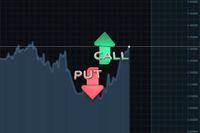Explore web search results related to this domain and discover relevant information.

Put options are more complex than buying and selling stocks or index funds. In most cases, brokerage firms require that investors apply and be approved to buy options. You may also be asked to provide your annual income and net worth.
Put options are a fundamental investment strategy for options trading. Learn how put options work, different strategies, and the risks involved.Those who buy put option contracts are betting that the asset's price will fall, somewhat similar to short-selling stock. Some investors prefer to buy puts on certain assets rather than shorting a stock since put options are potentially more profitable.Put options become more valuable as the underlying stock's price falls and loses value when the stock's price rises. Generally, the value of a put option can also decrease as it approaches the expiration date. This is known as time decay; Cummings suggests purchasing contracts that go out at least 45-60 days to minimize this.The process of determining the profitability of an option is found using intrinsic value, which is calculated for a put option by subtracting the underlying asset's price from the strike price. For example, the strike price was $100, and the current price is $80.
A stable value term (unrelated to derivatives) that describes the ability of a plan to exit a stable value commingled fund at contract value, subject to a specified notice period. A put option may mean either (1) a provision under the fund documentation that an invested plan can exit the fund ...
A stable value term (unrelated to derivatives) that describes the ability of a plan to exit a stable value commingled fund at contract value, subject to a specified notice period. A put option may mean either (1) a provision under the fund documentation that an invested plan can exit the fund at contract value by the end of […]A stable value term (unrelated to derivatives) that describes the ability of a plan to exit a stable value commingled fund at contract value, subject to a specified notice period. A put option may mean either (1) a provision under the fund documentation that an invested plan can exit the fund at contract value by the end of a notice period or (2) a provision that many investment managers of stable value commingled funds request in their stable value investment contracts, allowing them to remove invested assets at contract value for purposes of funding plan-initiated withdrawals within the put period.

WisdomTree Equity Premium Income Fund (WTPI) is a hedged premium income ETF offering monthly dividends & S&P 500 exposure via a put-write strategy.
The Fund will invest in derivatives, including put options on the SPDR S&P 500 ETF Trust (“SPY Puts”). Derivative investments can be volatile, and these investments may be less liquid than securities, and more sensitive to the effects of varied economic conditions.Although the Fund collects premiums on the SPY Puts it writes, the Fund’s risk of loss if the price of SPY falls below the strike price and the SPY Puts are exercised as of the Roll Date may outweigh the gains to the fund from the receipt of such option premiums.The sale of cash-secured SPY Puts serves to partially offset a decline in the price of SPY to the extent of the premiums received. The potential return to the Fund is limited to the amount of option premiums it receives; however, the Fund can potentially lose up to the entire strike price of each option it sells.By virtue of its put option sales strategy, Fund returns will be subject to an upside limitation on returns attributable to SPY, and the Fund will not participate in gains beyond such upside limitation. The Fund's investment strategy is subject to risks related to rolling.
Call and put options. The difference between buying and writing options. The benefits, risks, and tax implications of trading options. Options are contracts that give you the right to take a specific action in the future, if it'll benefit you. Options trading can allow investors to hedge existing investments from potential downturns or speculate on the price movements of stocks, exchange-traded funds ...
Call and put options. The difference between buying and writing options. The benefits, risks, and tax implications of trading options. Options are contracts that give you the right to take a specific action in the future, if it'll benefit you. Options trading can allow investors to hedge existing investments from potential downturns or speculate on the price movements of stocks, exchange-traded funds (ETFs), and indexes.New to options trading? Understand the key differences between call and put options and how to use them effectively in your investment strategy.In the money (ITM). A call option is considered ITM if the current price of the underlying stock is higher than the strike price. For a put option, it means the current price of the underlying stock is lower than the strike price.Out of the money (OTM). A call option is considered OTM if the current price of the underlying stock is lower than the strike price. For a put option, it means the current price of the underlying stock is higher than the strike price.


HomeNewsBusinessMarketsUS-focused funds: 13 funds with Rs 50,000-crore corpus see the steepest cuts; experts suggest staying put till dust settles
While it is difficult to say that US stocks are currently a good bet, experts are taking cautious, stock-specific calls.Experts suggest that investors keep a watch on how this plays out, investing in the right opportunities but not to be in a hurry to quit. Fund managers too are keeping a watch on their portfolio and not planning to completely exit their portfolios.The biggest impact over the last two days has been for "Mag 7" stocks—The "Magnificent Seven" comprise Alphabet Inc, Amazon.com Inc, Apple Inc, Meta Platforms Inc, Microsoft Corp, Nvidia Corp and Tesla Inc—with the total market capitalisation erosion of these scrips amounting to $1.8 trillion. As per primemfdatabase.com, as on February 28, 2025, mutual fund holdings in US stocks were the highest in these Mag 7 stocks with Alphabet Inc.Among mutual funds, passive schemes with the highest exposure to US stocks include Mirae Asset NYSE FANG+ ETF (100 percent invested in US stocks), Mirae Asset S&P 500 Top 50 ETF (99 percent) and Motilal Oswal NASDAQ Q 50 ETF (99.6 percent).
You can put property or other assets into a trust set up for your loved ones. If you survive for seven years afterwards, these fall out of your estate for inheritance tax purposes. You can exert control over how assets in a trust might be used – for example you could stipulate beneficiaries ...
You can put property or other assets into a trust set up for your loved ones. If you survive for seven years afterwards, these fall out of your estate for inheritance tax purposes. You can exert control over how assets in a trust might be used – for example you could stipulate beneficiaries can only access funds from a certain age or for particular purposes, such as university fees or buying a home.Putting assets into trust can offer many benefits, for example to reduce your inheritance tax bill or to create a legacy for loved ones.JOHCM UK EQUITY INCOME FUND waves flag for UK stock market's cheap dividend stars‘There is no inheritance tax on creation of such trusts or ten-yearly charges as the idea is to accumulate funds to support the vulnerable beneficiary.’

Put options are a type of option that increases in value as a stock falls. A put allows the owner to lock in a predetermined price to sell a specific stock, while put sellers agree to buy the stock at that price.
Put options are a type of option that increases in value as a stock falls. A put allows the owner to lock in a predetermined price to sell a specific stock, while put sellers agree to buy the stock at that price.A put option gives you the right, but not the obligation, to sell a stock at a specific price (known as the strike price) by a specific time — at the option’s expiration. For this right, the put buyer pays the seller a sum of money called a premium.A put owner profits when the premium paid is lower than the difference between the strike price and stock price at option expiration. Imagine a trader purchased a put option for a premium of 80 cents with a strike price of $30 and the stock is $25 at expiration.Buying or selling a put option requires an investor to correctly input exactly the option they want, including many variables. There are often literally dozens of different choices for any option security, and you need to know which one you want to buy or sell.

A put option (or “put”), which gives the holder the right to sell, can be contrasted with a call option, which provides the holder with the right to buy the underlying security at a specified price, up until the option contract's expiration date.
Put options are derivatives that give their holders the right, but not the obligation, to sell an underlying asset (e.g., a stock, currency, bond, commodity, future, or index) at a set price by a pre-established date.A put option (or “put”), which gives the holder the right to sell, can be contrasted with a call option, which provides the holder with the right to buy the underlying security at a specified price, up until the option contract's expiration date.Out-of-the-money (OTM) and at-the-money (ATM) put options have no intrinsic value because there's no benefit in exercising the option. Investors have the option of short-selling the stock at the current higher market price, rather than exercising an OTM put option at an undesirable strike price.Time value, or extrinsic value, is reflected in the premium of the option. If the strike price of a put option is $20, and the underlying stock is currently trading at $19, there's $1 of intrinsic value in the option. But the put option may trade for $1.35. The extra $0.35 is time value, as the underlying stock price could change before the option expires.
:max_bytes(150000):strip_icc()/putoption-Final-37c324dca2c64f1b90eb19f979e1a57d.jpg)

Investment funds buy various different types of investment with the money that's paid in. We call this “diversifying” and it means you’re not relying on just one asset (such as shares in one company) to make you money. If you’re just getting started with investing, putting your money ...
Investment funds buy various different types of investment with the money that's paid in. We call this “diversifying” and it means you’re not relying on just one asset (such as shares in one company) to make you money. If you’re just getting started with investing, putting your money in an investment fund can be a safer way to invest than choosing individual assets yourself as the fund doesn't just rely on one investment to make money.Read on to find out how investment funds work and what you should look for when you’re choosing a fund. To put it simply, an investment fund is an account with lots of different people’s money in it.When you pay into a fund, your money is grouped with the money that other people have paid in. You then own part of the fund. The more money you put in, the more you own. This is measured in “units” or “shares” and the price of the units/shares changes depending on how much the fund is worth.Nothing is guaranteed and the value of any fund can go down. But because funds invest in many different assets, the chances of them all losing money at the same time is lower than if you put all your money in one place.
Each month, the Fund determines the amount of distribution to pay based on a combination of expected premiums and gains (collectively referred to as “premiums”) from writing put options, the portion of such premiums to be included in such distribution and the accrued interest from the Fund’s ...
Each month, the Fund determines the amount of distribution to pay based on a combination of expected premiums and gains (collectively referred to as “premiums”) from writing put options, the portion of such premiums to be included in such distribution and the accrued interest from the Fund’s fixed income investments, net of expenses, during that period.NBOS began as the Neuberger Berman U.S. Equity Index PutWrite Strategy Fund (Predecessor Fund), an open-end mutual fund which operated since September 16, 2016.An option-based strategy that seeks risk-efficient returns and aims to provide a diversifying source of yield for investors through collateral and option premium incomePrior to the close of business on 1/26/2024, the ETF operated as an open-end mutual fund. The NAV returns include returns of the Institutional Class Shares of the Predecessor Fund prior to the ETF's commencement of operations.
Search for news, funds, fund managers, sectors and asset classes
President Donald Trump signed an executive order Monday establishing a sovereign wealth fund for the United States and hinted TikTok could be put in the fund, following through on a proposal he floated in September while running for office.
Trump hinted his administration could use the fund “for Tik Tok,” saying at the signing: “We’re going to be doing something perhaps with Tik Tok, and perhaps not. If we make the right deal we’ll do it, otherwise we won’t. But I have a right to do that and we might put that in the sovereign wealth fund, whatever we make.” A law banning TikTok in the U.S.It’s not clear where the money to create the sovereign wealth fund is coming from, but Treasury Secretary Scott Bessent said the hope is to get it up within the next 12 months.Trump’s order charges the Treasury and Commerce departments to begin the process of creating a sovereign wealth fund—which is a state-owned fund that can invest in stocks, real estate, bonds, hedge funds and more to build a pool of money that can be used to insulate the government from economic stressors.Sovereign wealth funds are more common in non-Western countries like Saudi Arabia, China and the United Arab Emirates. Other countries that have had them include Norway, Kuwait, Singapore, Qatar, Australia and Russia, according to Reuters.
A put option ("put") is a contract that gives the owner the right to sell an underlying security at a set price (“strike price”) before a certain date (“expiration”).
Funding your businessSmall-business loansSBA loansBusiness lines of creditBusiness grantsStartup business loansBut when it comes to the basics, they work like this: The value of a put increases as the underlying stock value decreases, and conversely, the value of a put decreases when the underlying value of the stock increases.For a put buyer, if the market price of the underlying stock moves in your favor, you can elect to "exercise" the put option or sell the underlying stock at the strike price. American-style options allow the put holder to exercise the option at any point up to the expiration date.Depending on how you think a stock might move, put options can help you make money if your view comes true.

A put option gives the holder the right to sell a certain amount of an underlying asset at a set price before the contract expires but does not oblige the holder to do so.
A put is a contract sold in the options market that gives its owner the right, but not the obligation, to sell a certain amount of the underlying asset at a set price within a specific time. The buyer of a put option believes that the underlying stock will drop below the exercise price before the expiration date.Because put options, when exercised, provide a short position in the underlying asset, they are used for hedging purposes or to speculate on downside price action. Investors often use put options in a risk-management strategy known as a protective put.In general, the value of a put option decreases as the expiration date approaches because the probability of the stock falling below the specified strike price decreases. When an option loses its time value, the intrinsic value is left over, which is equivalent to the difference between the strike price minus the underlying stock price.The potential loss for a put buyer is limited to the premium they paid, while the potential profit is unlimited.
:max_bytes(150000):strip_icc()/put.asp-final-996d5c5afd724a0e9a7f239da5236ff8.jpg)

Trading options comes with risks, ... If you’re able to pay your bills, you have an emergency fund, you’re saving for retirement and you understand the risks of options trading, feel free to buy or sell some puts and calls with any “extra money” you can afford to ...
Trading options comes with risks, and the Securities and Exchange Commission recommends you understand how options strategies work before investing. If you’re able to pay your bills, you have an emergency fund, you’re saving for retirement and you understand the risks of options trading, feel free to buy or sell some puts and calls with any “extra money” you can afford to lose.The options-trading world is complicated and can involve a lot of jargon. One of its most fundamental concepts — the call vs. put distinction — can be confusing for many beginners.The call vs. put distinction can be confusing to options-trading beginners. Here’s what you need to know about the difference between puts and calls.Funding your businessSmall-business loansSBA loansBusiness lines of creditBusiness grantsStartup business loans

Welcome to the world of put options, where experienced investors unlock opportunities beyond simply buying and selling stocks and exchange-traded funds.
Put options work as insurance policies for investors, offering the ability to limit potential losses during market uncertainty.Picture it as an insurance policy for your investments, offering flexibility to sell assets at a fixed price, even during market declines. Additionally, put options allow for portfolio protection amidst market uncertainty.At the most basic level, put options serve as a financial safety net, safeguarding investments from potential downturns.Let's delve into the core essence of put options with a focus on their investor-centric advantages.

Investors commonly implement such a strategy during periods of uncertainty, such as earnings season. They may buy puts on particular stocks in their portfolio or buy index puts to protect a well-diversified portfolio. Mutual fund managers often use puts to limit the fund’s downside risk exposure.
An option is a derivative contract that gives the holder the right, but not the obligation, to buy or sell an asset by a certain date at a specified price.An option is a derivative, a contract that gives the buyer the right, but not the obligation, to buy or sell the underlying asset by a certain date (expiration date) at a specified price (strike price). There are two types of options: calls and puts. American-style options can be exercised at any time prior to their expiration.Puts give the buyer the right, but not the obligation, to sell the underlying asset at the strike price specified in the contract. The writer (seller) of the put option is obligated to buy the asset if the put buyer exercises their option.A put option gives the buyer the right to sell the underlying asset at the option strike price. The profit the buyer makes on the option depends on how far below the spot price falls below the strike price. If the spot price is below the strike price, then the put buyer is “in-the-money.” If the spot price remains higher than the strike price, the option will expire unexercised.

The NFOs open were Axis Services ... and Financial Services Fund, Nippon India MNC Fund and Sundaram Multi-Factor Fund. Given this widespread and the large inflows, its safe to say NFOs have put the sectoral and thematic category back in business...
The NFOs open were Axis Services Opportunities Fund, Bandhan Multi-Factor Fund, HDFC Innovation Fund, ICICI Prudential Active Momentum Fund, Mahindra Manulife Banking and Financial Services Fund, Nippon India MNC Fund and Sundaram Multi-Factor Fund. Given this widespread and the large inflows, its safe to say NFOs have put the sectoral and thematic category back in businessHe explained that the inflow is more to do with the size itself of the fund house and the offer. The fatigue of lack of fresher themes also saw a turn-around thanks to NFOs into strategies like multi-factor and momentum. "Liquidity have never been a problem in the Indian markets so its more about the big names coming with thematic ideas and pulling investors back in. Investors have the liquidity right now and are willing to put it into newer ideas," said Gang.A year ago, in August 2024, the inflows into the category stood at a whopping Rs 18,117 crore according to data from the Association of Mutual Funds. Since the beginning of this year, the inflows have been wonky, dipping to Rs 170.09 crore in March. Though inflows recovered from lows, it hovered just around Rs 2,000 crore.Personal FinanceOver 1000% Surge In Inflows In July: Here's What Put Sectoral And Thematic Funds Back In Business

The WisdomTree Putwrite Strategy Fund (PUTW) is now the WisdomTree Equity Premium Income Fund (WTPI). The change is mainly to the fund’s name and alerts investors immediately to the fact that its underlying strategy aims to provide them with income.
The NYSE Arca still lists WTPI, which still has a net expense ratio of 0.44%. The fund continues to track the price and performance of the Volos U.S. Large Cap Target 2.5% PutWrite Index (VULPW25 Index).PUTW was formerly the CBOE S&P 500 PutWrite Strategy Fund and tracked the CBOE S&P 500 PutWrite Index.The WisdomTree Putwrite Strategy Fund (PUTW) is now listed as the WisdomTree Equity Premium Income Fund (WTPI).Historically, PUTW performed better in low-volatility or flat markets over various market cycles. ETFs like WTPI offer a cushion to offset some of the potential losses if the market declines sharply.

Staying Put are excited to announce that they have been awarded £20,000 from the National Lottery Community Fund. The money will be used to fund an IT tutor for their refuges to help the residents with CV writing and IT skills. “We recognise the impact domestic abuse can have on individuals’ ...
Staying Put are excited to announce that they have been awarded £20,000 from the National Lottery Community Fund. The money will be used to fund an IT tutor for their refuges to help the residents with CV writing and IT skills. “We recognise the impact domestic abuse can have on individuals’ self-esteem, confidence, and mental […]“We are always looking for ways to provide practical solutions to survivors of domestic abuse and sexual violence,” states Yasmin Khan, CEO Staying Put Group. “The funding from the National Lottery Community Fund will add real value and will ensure that we can support women to build up their confidence and gain IT skills whilst living in our accommodation, which they need for independent living.”As part of this, we support the funder four key missions, which are to support communities to come together, be environmentally sustainable, help children and young people thrive and enable people to live healthier lives.National Lottery players raise over £30 million a week for good causes across the UK. Thanks to them, last year (2023/24) The National Lottery Community Fund awarded over half a billion pounds (£686.3 million) of life-changing funding to communities across the UK, supporting over 13,700 projects to turn their great ideas into reality.




:max_bytes(150000):strip_icc()/putoption-Final-37c324dca2c64f1b90eb19f979e1a57d.jpg)

:max_bytes(150000):strip_icc()/put.asp-final-996d5c5afd724a0e9a7f239da5236ff8.jpg)